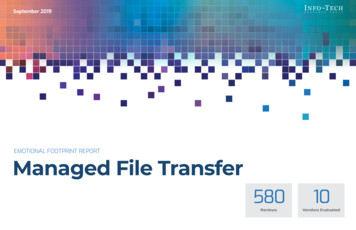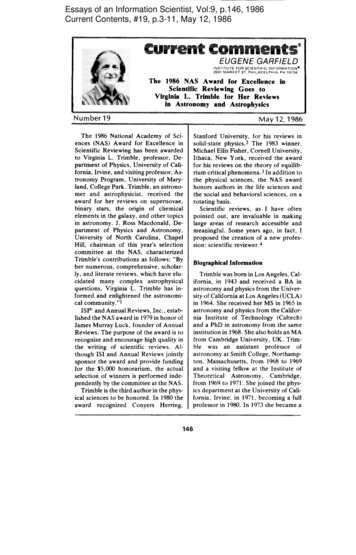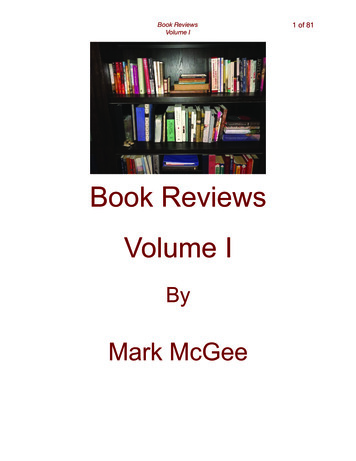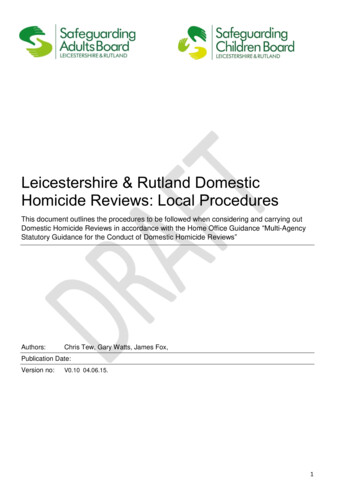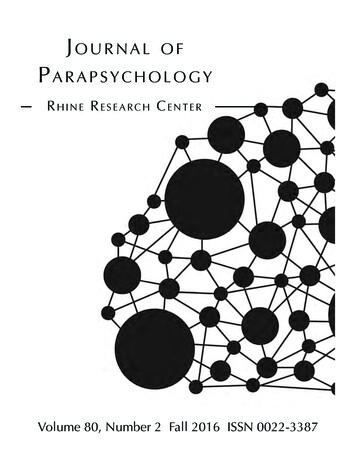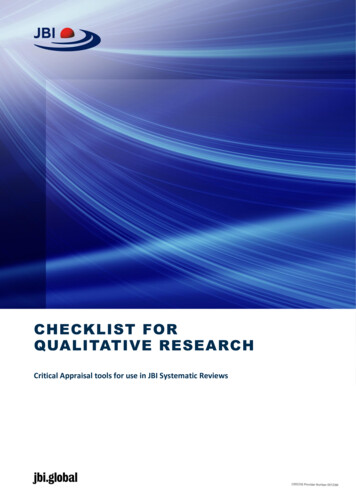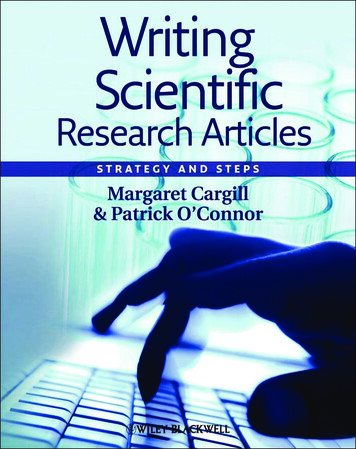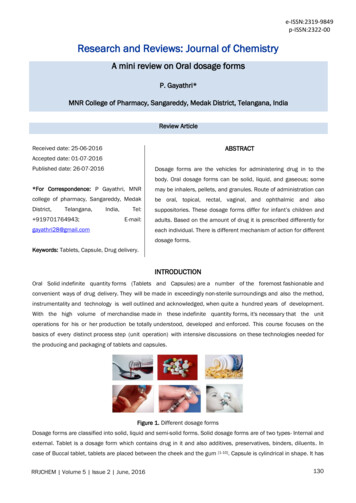
Transcription
e-ISSN:2319-9849p-ISSN:2322-00Research and Reviews: Journal of ChemistryA mini review on Oral dosage formsP. Gayathri*MNR College of Pharmacy, Sangareddy, Medak District, Telangana, IndiaReview ArticleABSTRACTReceived date: 25-06-2016Accepted date: 01-07-2016Published date: 26-07-2016Dosage forms are the vehicles for administering drug in to thebody. Oral dosage forms can be solid, liquid, and gaseous; some*For Correspondence: P Gayathri, MNRmay be inhalers, pellets, and granules. Route of administration cancollege of pharmacy, Sangareddy, Medakbe oral, topical, rectal, vaginal, and ophthalmic and alsoDistrict,Tel:suppositories. These dosage forms differ for infant’s children andE-mail:adults. Based on the amount of drug it is prescribed differently forTelangana, 919701764943;India,gayathri28@gmail.comeach individual. There is different mechanism of action for differentdosage forms.Keywords: Tablets, Capsule, Drug delivery.INTRODUCTIONOral Solid indefinite quantity forms (Tablets and Capsules) are a number of the foremost fashionable andconvenient ways of drug delivery. They will be made in exceedingly non-sterile surroundings and also the method,instrumentality and technology is well outlined and acknowledged, when quite a hundred years of development.With the high volume of merchandise made in these indefinite quantity forms, it's necessary that the unitoperations for his or her production be totally understood, developed and enforced. This course focuses on thebasics of every distinct process step (unit operation) with intensive discussions on these technologies needed forthe producing and packaging of tablets and capsules.Figure 1. Different dosage formsDosage forms are classified into solid, liquid and semi-solid forms. Solid dosage forms are of two types- Internal andexternal. Tablet is a dosage form which contains drug in it and also additives, preservatives, binders, diluents. Incase of Buccal tablet, tablets are placed between the cheek and the gum [1-10]. Capsule is cylindrical in shape. It hasRRJCHEM Volume 5 Issue 2 June, 2016130
e-ISSN:2319-9849p-ISSN:2322-00two parts: cap and body. Drug is filled in between the cap and body. They are of two types’ hard gelatin and softgelatin capsules. External can be Tooth powders and dusting powders. Tooth powders can be of different type’sdetergents. Preservatives and colors etc. Liquid dosage forms can be classified as monophasic and biphasic phasemeans direction.Figure 2. CapsulesMonophasic dosage forms include syrup. Elixir. and Oral drops. This syrup contains preservatives .additives, bindingagent’s etc .These syrups contain drug inside in liquid it shows effect easily. Proper dose should be maintained.Biphasic dosage forms can be suspension or emulsion. Suspension contains drug in suspended form, where inemulsion contains drug in the form two immiscible liquids. Emulsions are usually water in oil or oil in water type.Semisolid dosage forms are external and internal. They usually applied topically on skin. They include ointments,lotions, liniments .internal include pessaries and suppositaries rectal or vaginal devices [11-20].Figure 3. Syrup: A liquid formThere is another route of administration of drug which includes parenterals. These are sterile preparations whichcontains drug in the form of ampoules or vials. These injections can be intravenous (to vein) intramuscular (tomuscle) or subcutaneous (to skin). Inhaler is also used for asthma patients. Nebulizer is used for reducing blockagein the nostrils for small children [21-40].RRJCHEM Volume 5 Issue 2 June, 2016131
e-ISSN:2319-9849p-ISSN:2322-00Figure 4. InjectionsAdvantages of solid dosage forms include: Safe, less expensive, immediate relief Accurate dose, releases drug over a long period Can be used for all age groups, convenient, cheap Absorption is fast, pain less Less space for storage Less spoilage and less microbial contamination Action is more rapid in liquid dosage formDisadvantages of solid dosage forms include: Bitter in taste, Difficulty in swallowing Irritation to gastro intestinal tract–nausea and vomiting Unable to use for unconscious patients For liquid dosage form storing is problematic Types of release drug in the human body Controlled release: It delivers drug at a predetermined place Sustained release: It releases drug as two portions once at a place and after some time in some other place Release rate is not constant [41-60]Defects of tablets: Capping; breaking of tablet horizontally Sticking: sticking to the die walls [61-88] Motling: it is due to improper mixing of color Picking: it is due to improper drying and lubrication of granules Cracking: cracking occurs due to improper granulationRRJCHEM Volume 5 Issue 2 June, 2016132
e-ISSN:2319-9849p-ISSN:2322-00Figure 5. Defects of tabletsCONCLUSIONOral dosage forms can be a tablet, a capsule or drops. This route of administration is safe and results are good.These are cheaper and everyone will be aware of some tablets. The only problem of tablets is acidity. This will bebalanced by taking anti-ulcer agents.REFERENCES1. Bapuji AT, et al. Bioequivalence Testing-Industry Perspective. J Bioequiv Availab. 2010; 2: 098-101.2. Semdé R, et al Bioequivalence in vitro evaluation of some antibacterial generic dosage forms. J Pharm Belg.2005; 60: 51-55.3. Fassin D, et al. The Bamako Initiave-Letter. Lancet 1989; 333; 162-163.4. Sagui E. Stroke in sub-Saharan Africa. Med Trop. (Mars) 2007; 67: 596-600.5. Sauwakon R and Wondemagegnehu E. Effective drug regulation: A multicounty study. World HealthOrganization 2002: 1-202.6. Polli JE. In vitro studies are sometimes better than conventional human pharmacokinetic in vivo studies inassessing bioequivalence of immediate-release solid oral dosage forms. AAPSJ, 2008: 10:289-299.7. Anand O, et al. Dissolution testing for generic drugs: an FDA perspective. AAPS J 2011: 13: 328-335.8. Abelli C, et al. Equivalence pharmaceutiques des médicaments essentiels génériques. STP Pharma Pratiques .2001: 11: 89-101.9. Vander Meersch A. Quality of reporting of bioequivalence trials comparing generic to brand-name drugs: amethodological systematic review. 2011; PLoS One 6: e23611.10. Burgess DJ. Assuring quality and performance of sustained and controlled release parenterals: Workshopreport. AAP S pharm Sci B. 2002; 4: 13-23.11. Brown CK, et al. FIP/AAPS joint workshop report: dissolution/In vitro release testing of Novel/Special dosageforms. AAPS Pharm SciTech. 2011: 12: 782-794.RRJCHEM Volume 5 Issue 2 June, 2016133
e-ISSN:2319-9849p-ISSN:2322-0012. Siewert M, et al. FIP/AAPS guidelines to dissolution/In vitro release testing of novel/special dosage forms.AAPS Pharm Sci Tech. 2003: 4:43-52.13. Seidlitz A, et al. Biorelevant Dissolution Testing of Drug-Eluting Stents: Experiences with a Modified FlowThrough Cell Setup. Dissol Technol. 2011; 18: 26-34.14. Bhardwaj U and Burgess DJ. A novel USP apparatus 4 based release testing method for dispersed systems. IntJ Pharm. 388: 287-294.15. Rebucci M and Michiels C. Molecular aspects of cancer cell resistance to chemotherapy. Biochem Pharmacol.2013: 85: 1219-1226.16. Wu CP, et al. The emergence of drug transporter-mediated multidrug resistance to cancer chemotherapy. MolPharm. 2011: 8: 1996-2011.17. Moulder S. Intrinsic resistance to chemotherapy in breast cancer. Womens Health (Lond Engl) 2010; 6: 821830.18. Ullah MF. Cancer multidrug resistance (MDR): a major impediment to effective chemotherapy. Asian Pac JCancer Prev. 2008; 9: 1-619. Pauwels EK, et al. Multidrug resistance in cancer: its mechanism and its modulation. Drug News Perspect.2007; 20: 371-377.20. Teoh D and Secord AA. Antiangiogenic agents in combination with chemotherapy for the treatment of epithelialovarian cancer. Int J Gynecol Canc. 2012; 22: 348-359.21. Slovin S. Chemotherapy and immunotherapy combination in advanced prostate cancer. Clin Adv HematolOncol. 2012; 10: 90-100.22. Inoue K, et al. Factors affecting efficacy and safety of add-on combination chemotherapy for non-small-cell lungcancer: a literature-based pooled analysis of randomized controlled trials. Lung 2012; 190: 355-364.23. Hodge JW, et al. The tipping point for combination therapy: cancer vaccines with radiation, chemotherapy, ortargeted small molecule inhibitors. Semin Oncol. 2012; 39: 323-339.24. Bhattacharyya S and Khanduja KL. New hope in the horizon: cancer stem cells. Acta Biochim Biophys Sin.(Shanghai) 2010; 42: 237-242.25. Dean M. ABC transporters, drug resistance, and cancer stem cells. J Mammary Gland Biol Neoplasia. 2009; 14:3-9.26. Fábián A, et al. Die hard: are cancer stem cells the Bruce Willises of tumor biology? Cytometry A. 2009; 75: 6774.27. Mimeault M, et al. Functions of normal and malignant prostatic stem/progenitor cells in tissue regenerationand cancer progression and novel targeting therapies. Endocr Rev. 2008; 29: 234-252.28. Shah V, et al. Targeted nanomedicine for suppression of CD44 and simultaneous cell death induction inovarian cancer: an optimal delivery of siRNA and anticancer drug. Clin Cancer Res. 2013; 19: 6193-6204.29. Minko T, et al. New generation of liposomal drugs for cancer. Anticancer Agents Med Chem. 2006; 6: 537-552.30. Pakunlu RI, et al. Simultaneous modulation of multidrug resistance and antiapoptotic cellular defense by MDR1and BCL-2 targeted antisense oligonucleotides enhances the anticancer efficacy of doxorubicin. Pharm Res2003; 20: 351-359.31. Pakunlu RI, et al. In vitro and in vivo intracellular liposomal delivery of antisense oligonucleotides andanticancer drug. J Control Release. 2006; 114: 153-162.RRJCHEM Volume 5 Issue 2 June, 2016134
e-ISSN:2319-9849p-ISSN:2322-0032. Pakunlu RI, et al. Enhancement of the efficacy of chemotherapy for lung cancer by simultaneous suppressionof multidrug resistance and antiapoptotic cellular defense: novel multicomponent delivery system. Cancer Res.2004; 64: 6214-6224.33. Tiwari AK, et al. Revisiting the ABCs of multidrug resistance in cancer chemotherapy. Curr Pharm Biotechnol.2011; 12: 570-594.34. Chen ZS and Tiwari AK. Multidrug resistance proteins (MRPs/ABCCs) in cancer chemotherapy and geneticdiseases. FEBS J 2011; 278: 3226-3245.35. Noguchi K, et al. Functions of the breast cancer resistance protein (BCRP/ABCG2) in chemotherapy. Adv DrugDeliv Rev. 2009; 61: 26-33.36. Natarajan K, et al. Role of breast cancer resistance protein (BCRP/ABCG2) in cancer drug resistance. BiochemPharmacol. 2012; 83: 1084-1103.37. Veen HW and Konings WN. The ABC family of multidrug transporters in microorganisms. Biochim Biophys Acta.1998; 1365: 31-36.38. Loo TW and Clarke DM. Merck Frosst Award Lecture 1998. Molecular dissection of the human multidrugresistance P-glycoprotein. Biochem Cell Biol. 1999; 77: 11-23.39. Chaudhry P and Asselin E Resistance to chemotherapy and hormone therapy in endometrial cancer. EndocrRelat Can. 2009; 16: 363-380.40. Nicholson DW. From bench to clinic with apoptosis-based therapeutic agents. Nature. 2000; 407: 810-816.41. Dharap SS and Minko T. Targeted proapoptotic LHRH-BH3 peptide. Pharm Res. 2003; 20: 889-896.42. Dharap SS, et al. Tumor-specific targeting of an anticancer drug delivery system by LHRH peptide. Proc NatlAcad Sci USA. 2005; 102: 12962-12967.43. Garbuzenko OB, et al. Inhibition of lung tumor growth by complex pulmonary delivery of drugs with oligonucleotides as suppressors of cellular resistance. Proc Natl Acad Sci USA. 2010; 107: 10737-10742.44. Khandare JJ, et al. Novel polymeric prodrug with multivalent components for cancer therapy. J Pharmacol ExpTher. 2006; 317: 929-937.45. Taratula O, et al. Surface-engineered targeted PPI dendrimer for efficient intracellular and intratumoral siRNAdelivery. J Control Release 2009; 140: 284-293.46. Taratula A, et al Nanostructured lipid carriers as multifunctional nanomedicine platform for pulmonary codelivery of anticancer drugs and siRNA. J Control Release. 2013; 171: 349-357.47. Zhang M, et al. Two-in-one: combined targeted chemo and gene therapy for tumor suppression and preventionof metastases. Nanomedicine (Lond). 2012; 7: 185-197.48. Minko T, et al. Molecular targeting of drug delivery systems to cancer. Curr Drug Targets. 2004; 5: 389-406.49. Minko T, et al. Comparison of the anticancer effect of free and HPMA copolymer-bound adriamycin in humanovarian carcinoma cells. Pharm Res. 1999; 16: 986-996.50. Minko T, et al. Efficacy of the chemotherapeutic action of HPMA copolymer-bound doxorubicin in a solid tumormodel of ovarian carcinoma. Int J Can. 2000; 86: 108-11751. Sinha BK. Free radicals in anticancer drug pharmacology. Chem Biol Interact. 1989; 69: 293-317.52. Sinha BK and Mimnaugh EG. Free radicals and anticancer drug resistance: oxygen free radicals in themechanisms of drug cytotoxicity and resistance by certain tumors. Free Radic Biol Med. 1990; 8: 567-581.53. Getoff N. Vitamin free radicals and their anticancer action-Review. In Vivo. 2009; 23: 599-611.RRJCHEM Volume 5 Issue 2 June, 2016135
e-ISSN:2319-9849p-ISSN:2322-0054. Jaggi AS and Singh N. Mechanisms in cancer-chemotherapeutic drugs-induced peripheral neuropathy. Toxicol.2012; 291: 1-9.55. Lokeshwar BL. Chemically modified non-antimicrobial tetracyclines are multi-functional drugs against advancedcancers. Pharmacol Res. 2011; 63: 146-150.56. Montero AJ and Jassem J. Cellular redox pathways as a therapeutic target in the treatment of cancer. Drugs2011; 71: 1385-1396.57. Tertil M, et al. Oxidative stress in tumor angiogenesis-therapeutic targets. Curr Pharm Des. 2010; 16: 38773894.58. Niki E, et al. Lipid peroxidation: mechanisms, inhibition, and biological effects. Biochem Biophys Res Commun2005; 338: 668-676.59. Yin H, et al. Free radical lipid peroxidation: mechanisms and analysis. Chem Rev. 2011; 111: 5944-5972.60. Cheeseman KH. Mechanisms and effects of lipid peroxidation. Mol Aspects Med. 1993; 14: 191-197.61. Amara AA. The philosophy behind exo/endo/existing antioxidants and our built-in oxidant and antioxidantsystem. Pharmazie. 2010; 65: 711-719.62. Irshad M and Chaudhuri PS. Oxidant-antioxidant system: role and significance in human body. Indian J Exp Biol.2002; 40: 1233-1239.63. Singh S and Dash AK. Paclitaxel in cancer treatment: perspectives and prospects of its delivery challenges. CritRev Ther Drug Carrier Syst. 2009; 26: 333-372.64. Coombes RC, et al. A randomized trial of exemestane after two to three years of tamoxifen therapy inpostmenopausal women with primary breast cancer. N Engl J Med. 2004; 350: 1081-1092.65. Weisberg E, et al. Second generation inhibitors of BCR-ABL for the treatment of imatinib-resistant chronicmyeloid leukaemia. Nat Rev Cancer. 2007; 7: 345-356.66. Gottesman MM, et al. Multidrug resistance in cancer: role of ATP-dependent transporters. Nat Rev Cancer2002; 2: 48-58.67. Ali S and Coombes RC. Endocrine-responsive breast cancer and strategies for combating resistance. Nat RevCancer. 2002; 2: 101-112.68. Weinberg OK, et al. New approaches to reverse resistance to hormonal therapy in human breast cancer. DrugResist Updat. 2005; 8: 219-233.69. Dowsett M and Haynes B. Hormonal effects of aromatase inhibitors: focus on premenopausal effects andinteraction with tamoxifen. J Steroid Biochem Mol Biol. 2003; 86: 255-263.70. Zhou Q, et al. Histone deacetylase inhibitor LBH589 reactivates silenced estrogen receptor alpha (ER) geneexpression without loss of DNA hypermethylation. Canc Biol Ther. 2007; 6: 64.71. Fan P, et al. Long-term treatment with tamoxifen facilitates translocation of estrogen receptor alpha out of thenucleus and enhances its interaction with EGFR in MCF-7 breast cancer cells. Canc Res. 2007; 67: 13521360.72. Arpino G et al. Crosstalk between the estrogen receptor and the HER tyrosine kinase receptor family: molecularmechanism and clinical implications for endocrine therapy resistance. Endocr Rev. 2008; 29: 217-233.73. Razandi M, et al. Tamoxifen regulates cell fate through mitochondrial estrogen receptor beta in breast cancer.Oncogene 2013; 32: 3274-3285.74. Johnston SR New strategies in estrogen receptor-positive breast cancer. Clin Cancer Res. 2010; 16: 19791987.RRJCHEM Volume 5 Issue 2 June, 2016136
e-ISSN:2319-9849p-ISSN:2322-0075. Samaddar, et al. A role for macroautophagy in protection against 4-hydroxytamoxifen-induced cell death andthe development of antiestrogen resistance. Mol Cancer Ther. 2008; 7: 2977-2987.76. Peer D and Margalit R. Fluoxetine and reversal of multidrug resistance. Cancer Lett. 2006; 237: 180-187.77. Haran G. Transmembrane ammonium-sulfate gradients in liposomes produce efficient and stable entrapmentof amphipathic weak bases. Biochim Biophys Acta. 1993; 115: 201-215.78. Gabizon AA, et al. Pros and cons of the liposome platform in cancer drug targeting. J Liposome Res. 2006; 16:175-183.79. Lorusso D, et al. Pegylated liposomal doxorubicin-related palmar-plantar erythrodysesthesia ('hand-foot'syndrome). Ann Oncol. 2007; 18: 1159-1164.80. Couvreur P and Vauthier C. Nanotechnology: intelligent design to treat complex disease. Pharm Res. 2006; 23:1417-1450.81. Alonso MJ. Nanomedicines for overcoming biological barriers. Biomed Pharmacother. 2004; 58: 168-172.82. Matsumura Y and Maeda HA. New concept for macromolecular therapeutics in cancer chemotherapy Mechanism of tumoritropic accumulation of proteins and the antitumor agent smancs. Cancer Res. 1986; 46:6387-6392.83. Yuan F, et al. Vascular permeability in a human tumor xenograft: molecular size dependence and cutoff size.Cancer Res. 1995; 55: 3752-3756.84. Torchilin VP. Recent advances with liposomes as pharmaceutical carriers. Nat Rev Drug Discov. 2005; 4: 145160.85. Hobbs SK, et al. Regulation of transport pathways in tumor vessels: role of tumor type and microenvironment.Proc Natl Acad Sci USA. 1998; 95: 4607-4612.86. Jain RK. Barriers to drug delivery in solid tumors. Sci Am. 1994; 271: 58-65.87. Lopes de Menezes DE, et al. In vitro and in vivo targeting of immunoliposomal doxorubicin to human B-celllymphoma. Cancer Res. 1998; 58: 3320-3330.88. Park JW. Anti-HER2 immunoliposomes: enhanced efficacy attributable to targeted delivery. Clin Cancer Res.2002: 8: 1172-1181.RRJCHEM Volume 5 Issue 2 June, 2016137
Figure 1. Different dosage forms Dosage forms are classified into solid, liquid and semi-solid forms. Solid dosage forms are of two types- Internal and external. Tablet is a dosage form which contains drug in it and also additives, preservatives, binders, diluents. In case of Buccal tablet, tablets are placed between the cheek and the gum [1-10 .

